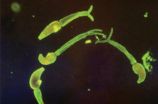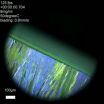(Press-News.org) Amsterdam, April 16, 2014 - Fish exposed to the antidepressant Fluoxetine, an active ingredient in prescription drugs such as Prozac, exhibited a range of altered mating behaviours, repetitive behaviour and aggression towards female fish, according to new research published on in the latest special issue of Aquatic Toxicology: Antidepressants in the Aquatic Environment.
The authors of the study set up a series of experiments exposing a freshwater fish (Fathead Minnow) to a range of Prozac concentrations. Following exposure for 4 weeks the authors observed and recorded a range of behavioural changes among male and female fish relating to reproduction, mating, general activity and aggression. On a positive note, author Rebecca Klaper, Director of the Great Lakes Genomics Center at University of Wisconsin-Milwaukee, emphasizes that the impact on behaviour is reversible once the concentration level is reduced.
"With increased aggression, in the highest level of concentration, female survivorship was only 33% compared to the other exposures that had a survivorship of 77–87.5%. The females that died had visible bruising and tissue damage," according to Rebecca Klaper.
There is an increasing proportion of antidepressants prescriptions, and like most prescription drugs, they end up, not fully broken down, back into our aquatic ecosystems, inducing their therapeutic effects on wildlife. Although concentrations observed in our rivers and estuaries are very small, an increasing number of studies have shown that these incredibly small concentrations can dramatically alter the biology of the organisms they come in contact with.
The impact of pharmaceuticals is currently not only of interest amongst scientists but also amongst environmental regulators, industry and general public. Some US states are looking to charge pharmaceutical companies with the cost of appropriate drug disposal, some of which is currently being challenged in the courts.
"This is just one of an increasing number of studies that suggest that pharmaceuticals in the environment can impact the complex range of behaviours in aquatic organisms," said Alex Ford, Guest Editor of the special issue of Aquatic Toxicology in which the study was published. "Worryingly, an increasing number of these studies are demonstrating that these effects can be seen at concentrations currently found in our rivers and estuaries and they appear to impact a broad range of biological functions and a wide variety of aquatic organisms."
This is one of the reasons why Alex proposed a full special dedicated to this topic. Antidepressants in the Aquatic Environment, includes among other studies, research that demonstrates that antidepressants affect the ability of cuttlefish to change colour and a fish study whereby reproductive effects were observed in offspring whose parents who were exposed to mood stabilizing drugs.
Ford emphasizes that although the results from this study and others published in the issue show troubling results for aquatic species, this doesn't indicate that these results are applicable to humans.
"This special issue focuses on the biology of aquatic systems and organisms and results only indicate how pharmaceuticals could potentially have effects on this particular environment."
INFORMATION:
Notes for editors
The special issue is: "Antidepressants in the Aquatic Environment" (Volume 151, Pages 1-134 (June 2014), Aquatic Toxicology published by Elsevier. Full texts of articles included in the special issue are available to credentialed journalists upon request; contact s.boucherie@elsevier.com or newsroom@elsevier.com.
About Aquatic Toxicology
Aquatic Toxicology publishes original scientific papers dealing with the mechanisms of toxicity and the responses to toxic agents in aquatic environments at the community, species, tissue, cellular, subcellular and molecular levels, including aspects of uptake, metabolism and excretion of toxicants. Aquatic Toxicology has an impact factor of 3.730 based on the Journal Citation Reports®, published by Thomson Reuters, 2013.
About Elsevier
Elsevier is a world-leading provider of information solutions that enhance the performance of science, health, and technology professionals, empowering them to make better decisions, deliver better care, and sometimes make groundbreaking discoveries that advance the boundaries of knowledge and human progress. Elsevier provides web-based, digital solutions — among them ScienceDirect, Scopus, Elsevier Research Intelligence, and ClinicalKey — and publishes nearly 2,200 journals, including The Lancet and Cell, and over 25,000 book titles, including a number of iconic reference works.
The company is part of Reed Elsevier Group PLC, a world leading provider of professional information solutions in the Science, Medical, Legal and Risk and Business sectors, which is jointly owned by Reed Elsevier PLC and Reed Elsevier NV. The ticker symbols are REN (Euronext Amsterdam), REL (London Stock Exchange), RUK and ENL (New York Stock Exchange).
Media contact
Kitty van Hensbergen
Elsevier
+31 20 485 2291
c.hensbergen@elsevier.com
Fish exposed to antidepressants exhibit altered behavioral changes
Special issue Aquatic Toxicology: Antidepressants in the Aquatic Environment dedicated to the topic of the impact of pharmaceuticals in the environment on biology of aquatic organisms
2014-04-16
ELSE PRESS RELEASES FROM THIS DATE:
Study: The trials of the Cherokee were reflected in their skulls
2014-04-16
Researchers from North Carolina State University and the University of Tennessee have found that environmental stressors – from the Trail of Tears to the Civil War – led to significant changes in the shape of skulls in the eastern and western bands of the Cherokee people. The findings highlight the role of environmental factors in shaping our physical characteristics.
"We wanted to look at these historically important events and further our understanding of the tangible human impacts they had on the Cherokee people," says Dr. Ann Ross, a professor of anthropology at NC ...
Progress in understanding immune response in severe schistosomiasis
2014-04-16
BOSTON (April 16, 2014) —Researchers at the Sackler School of Graduate Biomedical Sciences at Tufts and Tufts University School of Medicine (TUSM) have uncovered a mechanism that may help explain the severe forms of schistosomiasis, or snail fever, which is caused by schistosome worms and is one of the most prevalent parasitic diseases in the world. The study in mice, published online in The Journal of Immunology, may also offer targets for intervention and amelioration of the disease.
Schistosomiasis makes some people very sick whereas others tolerate it relatively well, ...
Floating nuclear plants could ride out tsunamis
2014-04-16
CAMBRIDGE, Mass-- When an earthquake and tsunami struck the Fukushima Daiichi nuclear plant complex in 2011, neither the quake nor the inundation caused the ensuing contamination. Rather, it was the aftereffects — specifically, the lack of cooling for the reactor cores, due to a shutdown of all power at the station — that caused most of the harm.
A new design for nuclear plants built on floating platforms, modeled after those used for offshore oil drilling, could help avoid such consequences in the future. Such floating plants would be designed to be automatically cooled ...
Bristol academics invited to speak at major 5G summit
2014-04-16
For more than 20 years academics from the University of Bristol have played a key role in the development of wireless communications. In particular, they have contributed to the development of today's Wi-Fi and cellular standards. Two Bristol engineers, who are leaders in this field, have been invited to a meeting of technology leaders to discuss the future of wireless communications. The first "Brooklyn 5G Summit" will be held next week [April 23-25] in New York, USA.
Andrew Nix, Professor of Wireless Communication Systems and Mark Beach, Professor of Radio Systems ...
Researchers question emergency water treatment guidelines
2014-04-16
The Environmental Protection Agency's (EPA's) recommendations for treating water after a natural disaster or other emergencies call for more chlorine bleach than is necessary to kill disease-causing pathogens and are often impractical to carry out, a new study has found. The authors of the report, which appears in the ACS journal Environmental Science & Technology, suggest that the agency review and revise its guidelines.
Daniele Lantagne, who was at the Centers for Disease Control and Prevention (CDC) at the time of the study and is now at Tufts University, and colleagues ...
Relieving electric vehicle range anxiety with improved batteries
2014-04-16
RICHLAND, Wash. – Electric vehicles could travel farther and more renewable energy could be stored with lithium-sulfur batteries that use a unique powdery nanomaterial.
Researchers added the powder, a kind of nanomaterial called a metal organic framework, to the battery's cathode to capture problematic polysulfides that usually cause lithium-sulfur batteries to fail after a few charges. A paper describing the material and its performance was published online April 4 in the American Chemical Society journal Nano Letters.
"Lithium-sulfur batteries have the potential to ...
Breakthrough points to new drugs from nature
2014-04-16
Researchers at Griffith University's Eskitis Institute have developed a new technique for discovering natural compounds which could form the basis of novel therapeutic drugs.
The corresponding author, Professor Ronald Quinn AM said testing the new process on a marine sponge had delivered not only confirmation that the system is effective, but also a potential lead in the fight against Parkinson's disease.
"We have found a new screening method which allows us to identify novel molecules drawn from nature to test for biological activity," Professor Quinn said.
"As it ...
Global scientific team 'visualizes' a new crystallization process
2014-04-16
VIDEO:
This is a high speed video of the crystal ribbons forming as the solution is spread using a squeegee like technique.
Click here for more information.
Sometimes engineers invent something before they fully comprehend why it works. To understand the "why," they must often create new tools and techniques in a virtuous cycle that improves the original invention while also advancing basic scientific knowledge.
Such was the case about two years ago, when Stanford engineers ...
Researchers propose network-based evaluation tool to assess relief operations feasibility
2014-04-16
The United Nations Office for Disaster Risk Reduction reported that disasters have affected around 2.9 billion people worldwide from 2000-2012— killing more than a million, and damaging around 1.7 trillion US dollars in estimates. Moreover, natural disasters and their damages have been documented to occur with increasing intensity. Given the staggering numbers, effective disaster preparedness and relief response plans is compelling, especially considering the fact that natural disasters are usually unpredictable and damage cannot be avoided.
Implementing a speedy and ...
Medieval slave trade routes in Eastern Europe extended from Finland and the Baltic Countries to Asia
2014-04-16
The routes of slave trade in Eastern Europe in the medieval and pre-modern period extended all the way to the Caspian Sea and Central Asia. A recent study completed at the University of Eastern Finland suggests that persons captured during raids into areas which today constitute parts of Finland, the Russian Karelia and the Baltic Countries ended up being sold on these remote trade routes. There was a particular demand for blonde girls and boys who were seen as exotic luxury items, and it was financially beneficial to transport them to the far-away markets. The study by ...
LAST 30 PRESS RELEASES:
Study uncovers disrupted brain balance in alcohol dependence
Working in groups can help Republicans and Democrats agree on controversial content moderation online
Structural findings reveal how distinct GPCR ligands create different levels of activation
Anything-goes “anyons” may be at the root of surprising quantum experiments
UC review: Maximizing workplace opportunity for veterans
From generation to complex control: Metasurfaces make perfect vortex beams "within reach"
Thin-film lithium niobate-based detector: recent advances and perspectives
Exploring why some people may tend to persistently make bad choices
How cells balance their protein levels
Nirsevimab vs RSVpreF vaccine for RSV–related hospitalization in newborns
Effectiveness and impact of maternal RSV immunization and nirsevimab on medically attended RSV in US children
AI gives scientists a boost, but at the cost of too many mediocre papers
Next-generation vision model maps tree growth at sub-meter precision
Genes aren’t destiny for inherited blindness, study shows
MIT study: High-fat diets make liver cells more likely to become cancerous
Exposure to multiple fine particulate matter components and incident depression in the US Medicare population
Risk of burdensome health care spending over time in the US
Nirsevimab against hospitalizations and emergency department visits for lower respiratory tract infection in infants
New microfluidics technology enables highly uniform DNA condensate formation
A new strategy for immune tolerance
Super Mario Bros. help fight burnout: New study links classic games to boosted happiness
Deepest gas hydrate cold seep ever discovered in the arctic: International research team unveils Freya Hydrate Mounds at 3,640 m depth.
Integrating light and structure: Smarter mapping for fragile wetland ecosystems
ACA-SIM: A robust way to decode satellite signals over complex waters
Probiotics can restore gut microbiome in breastfed infants
AI could help predict nutrition risks in ICU patients, study finds
Federal EITC has unexpected result, researchers say – it decreases domestic violence
Researchers identify gene that calms the mind and improves attention in mice
Artificial metabolism turns waste CO2 into useful chemicals
Ancient sea anemone sheds light on animal cell type evolution
[Press-News.org] Fish exposed to antidepressants exhibit altered behavioral changesSpecial issue Aquatic Toxicology: Antidepressants in the Aquatic Environment dedicated to the topic of the impact of pharmaceuticals in the environment on biology of aquatic organisms



